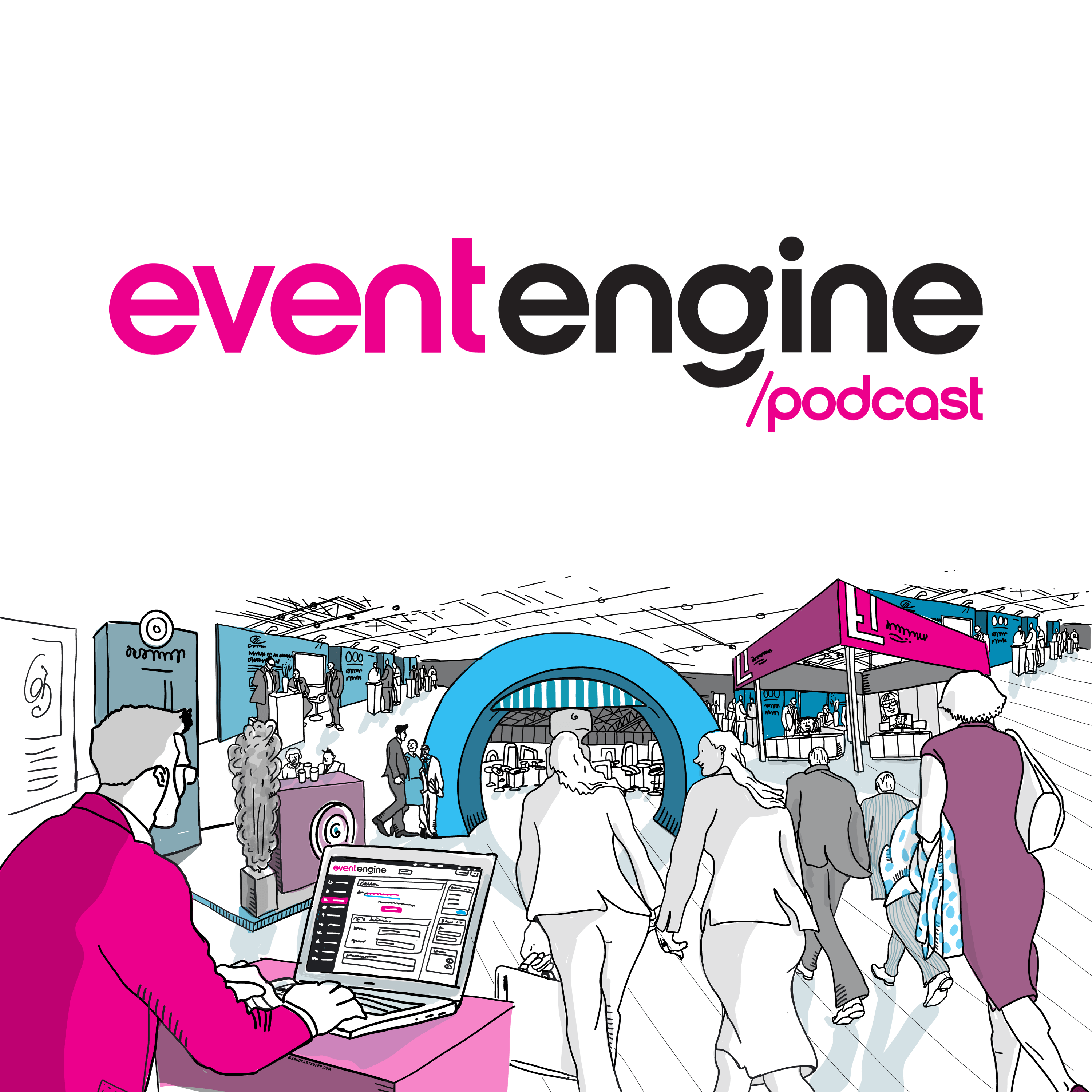We harness AI and voice recognition to generate transcripts, which we subsequently review and edit. However, due to conversational nuances and technical jargon, absolute accuracy cannot be guaranteed.
Lee
Welcome to the Event Engine podcast. This is your host, Lee, and today we have the one, the only, It’s Jennifer from MJ’s. Jennifer, how are you doing today?
Jennifer
I’m very good, thank you. Lee, how are you?
Lee
Awesome. I am very happy to see you and to finally connect. For people listening in, you won’t know, but me and Jennifer have had a few failed attempts to get together and record a podcast. So third time lucky, here we are and this is hopefully the one that will go live. So, Jennifer, it would be wonderful, just for those who don’t know who you are, for a little quick 660 second bio of yourself, who you are, where you’re from, etc.
Jennifer
Well, I’m Jennifer, as you’ve said, and I’m the COO of MJ’s Event Services. We’re a flooring supplier based out of Coleshill near Birmingham. We’ve been operational in the UK for about seven years now and we’ve been kind of instrumental in leading the way in terms of sustainable flooring and making sure that, you know, everything that we do for the industry is as sustainable as possible.
Lee
Yeah, that’s awesome. And could you jump in a time machine with us and maybe take us right back to the very inception of the company? And how did you get started? Was it in a restaurant and you were writing ideas on a napkin or were you working together? What’s the trajectory of launching the business?
Jennifer
No, of course. So we are born out of a group of companies in the uae. I’m actually here in Dubai at the moment. That’s where I run the company from. So our owners are based here in the UAE and they are the market leaders in flooring and furniture for exhibitions here in the UAE. Qatar, Saudi Arabia. And the MJ’s was born out of their pre existing relationships here that we were able to utilise in the UK and Europe as well.
Lee
Absolutely. Now, I’d never really cottoned on that. When you have an event, what will normally happen and people listening will already will tell me. It’s bleeding obvious, but a few years ago I had no idea that someone would carpet an event. They would then tear it all up and throw it away, which is utterly shocking to me, that concept. I didn’t realise how wasteful events were. So tell us a little bit about rewind flooring and how you’ve been able to change that.
Jennifer
Yeah, I think that’s the thing. Like this idea that it’s thrown away is the misconception and that’s what we’ve really Been trying to focus on the re education really quite recently because coming out of COVID which was of course difficult enough for the industry as a whole, we then had, we were then hit by the war in Ukraine which had a direct impact on the cost of our product. Only for then to be basically thrown under the bus by our own industry because all of a sudden carpet was the worst thing you could possibly use in an event and it all went to landfill and you know, people were putting stickers on the floor saying, well it untruths about carpet. There were, you know, bizarre facts that one had found on the Internet, I assume. But essentially speaking, we’ve been recycling and, and our competitors as well have also been recycling carpet for years and years and years. I mean we have since our inception. But if you look at some of the other players in the market who’ve been there a lot longer, they’ve also been recycling for a long, long time. So it really is a misconception that it’s thrown away.
Jennifer
This idea of thrown away is incorrect. I mean if you want to look at the industry as a whole, there is a lot of waste. But we literally take everything away from site. So all carpets get removed, all vinyl gets removed, every piece of flooring, every piece of off cut, every tube, everything that we use gets removed from site and taken away and recycled. So the tubes for example, come back to our warehouse. Some of them can’t be used again, so they go to cardboard recycling. The rest of them get reused for cut carpet shows. We specifically choose our vinyl supplier because they have a takeaway. It’s called a restart programme, but it basically goes back into being made into other PVC flooring. It’s a continual circular process basically. Yeah, exactly. And whilst we’ve always recycled, MJ’s has recycled our carpet since our inception. The, the traditional cord carpet that’s always been used in the uk, or most recently anyway, the ribbed carpet that has latex in it, whilst you can recycle it. When it is recycled, the latex means that it becomes a more brittle plastic and then will be used in plastic culverts and things like that.
Jennifer
So it will be recycled, it will be turned into something else for pipes under the ground or whatever, but that’s the end of its life. Whereas we’ve this year made the choice really on behalf of our clients to move permanently to Rewind carpet, which is a latex free carpet which uses 85% less water in its production, 55% less COT2. It’s heat bonded, so it doesn’t have the latex glue holding it together, which ultimately means that it is, it maintains as a pure polypropylene property. Therefore, when it’s recycled, the pellet is a high quality polypropylene pellet and can be recycled and sold into the plastics industry, negating the need for the use of virgin plastics for some products like, you know, you know, the dashboards in your car or something along those lines in the automotive industries.
Lee
That’s incredible. So, so what you’re saying here is, is with the Rewind carpet you’re able to fully break it down into something that’s absolutely usable into a completely new object. And there’s there’ essentially no waste here with regards to the, the old glue. That would limit what could be recycled, I think is what you’re saying.
Jennifer
Yeah, it would always be recycled, but it, it would limit the, the, well, ultimately when it returned into something it, that would, that, that second life would be then the end of its life. It was obviously it, if it’s a pipe under the ground, it’s going to be there forever and it will be for servicing, you know, electricity or whatever else goes into them. But the point with the, with the Rewind pellet is that it can become. As long as it stays as a pure polypropylene product, it can then be recycled what I’m told by a polymer expert up to 10 times thereafter.
Lee
That’s amazing, isn’t it?
Jennifer
So then you’re looking at a product that’s used. Yes. Okay. It’s used for what we, what do we use at 5, 6 days at an exhibition? But then it’s life if it’s, if it’s, if it’s got a 10 year life in a plastic product and it’s recycled 10 times, that’s an 100 year life on one piece of carpet.
Lee
Yeah. No, that is incredible. See, I’d always kind of assumed then that if someone was going to try and reuse a carpet that they would somehow cut it up and then try and put it into a new event. I didn’t quite realise that it was, it was this advanced. I was imagining you having to cut things up and then kind of reshape, etc. And reconnect.
Jennifer
Yeah, I mean ultimately when you’re talking about exhibition carpet, it’s the thinnest carpet available because it has to be light enough for us to move and manipulate and obviously it gets really dirty. It shows. I mean, we have to uplift all the gangways within one hour at the end of the show. Whether that’s 10,000 square metres or 100,000 square metres to prevent it from being contaminated. Because if there are contaminants in the carpet, it damages the recyclers, machines and it also negates, affects the quality of the pellet. So it’s really, really important to keep that the products as free from contaminants as possible. But we work in a dirty industry, a breakdown, because breakdowns, timings are getting shorter and shorter. Everybody’s just throwing everything into the gangways and of course we’re there trying to pull it all up and get it all out in a way that it can be recycled to the maximum of its properties, you know what I mean? So in some ways the industry almost works against itself in terms of the shorter the time gets. We all want to be more sustainable, but we’ve got less time to do it, which actually makes everybody’s life more complicated, because then you end up in this I’ll just get rid of it kind of mentality, which I’ve seen on site before.
Jennifer
And it’s like, no, no, no, no, no. There is a purpose to this process. We need an hour. Just give us an hour. We have to be the first ones to get this stuff up. We only need one hour. But obviously the pressure is on for everybody and we appreciate that, but it does make a huge, huge difference.
Lee
And then for the event organiser, what does that mean with regards to their own carbon footprint and offsetting, etc. What are the benefits there?
Jennifer
Well, obviously, everything we use, we recycle. And the good thing about recycling carpet is that it’s weighed by tonne when it goes into the recycler. So we know exactly by tonne how much or by kilogramme, how much we’ve delivered into site and therefore how much has been there and sent to the recycler. Obviously, you, most of the time you’re going to have a 2 or 3% variant because there will be pieces that get lost on site or people wrap their goods up in it or, you know, you know, you’re never going to manage every single piece, but as much as possible, we’re normally close to, you know, 97% of the carpet is recycled from each and every show and we have the data to support that. We provide a recycling certificate at the end of the show. We can tell the organiser exactly where it’s gone. And there’s a calculation, obviously based on perfect or the statistics for rewind, that they can calculate, therefore, exactly what the carbon footprint of that product is. How much water and carbon they’ve saved from not using the cord carpet to using the rewind carpet.
Lee
Yeah, no, that’s phenomenal. And then you also, I understand, do.
Jennifer
Furniture well, I mean, that’s what we’re developing at the moment. So obviously what, what we’re looking at in terms of. Because what most people will say about carpet is, well, can’t you just turn it into another piece of carpet? And when you’re talking about a product that is incredibly thin but has to be durable and have vibrant colours and, you know, work for the show, if you, if you try and use the recycled fibres in another piece of carpet or another to create a fibre form or carpet, ultimately you’ve, you’ve degraded the property of the fibre. So therefore to make it into a new fibre is incredibly difficult. But also it’s then only got another five day life cycle. Whereas what we’re looking at is can we make it into furniture where that furniture then can go back onto the exhibition floor and it will then be able to have a life of what? Depends on how much it gets thrown around an exhibition, of course. But, you know, five to ten years, let’s say. But ultimately we’re looking at like if you look at the prototypes that we’ve made at the moment, they’re all made of pure polypropylene.
Jennifer
They do not have a screw in them or glue in them. So therefore, when that even a single panel from those chairs or table that we’ve made, if that one of them is scratched, we just put it back into the process and it will get turned back into another panel and go back into another chair. So basically you’re creating a sort of endless life cycle for these products, which is ultimately we’re looking at creating a circular economy for our carpet. Okay, we use a lot of carpet, we’re talking about a huge amount of volume. Can we make as many products as we use carpet? That will remain to be seen. But in, in the first instance, what we would love to see is products that have been made out of carpet that make their way back onto the exhibition floor and can tell a truly circular story. So you can say these. And I’m not talking about a full range of furniture, obviously, I’m talking about a capsule collection, but something that can represent that. You can make a circular economy. And the product that was on the floor at one event is now being sat on at the next one.
Lee
That is phenomenal. And so there’s a company in Italy that makes a lot of plastic furniture and I can Just see now in my mind’s eye, some of the epic designs they come up with for really nice comfortable plastic chairs, which is just all, like you said, no screws or anything, it’s just all one unit. And that whole circular story you’re talking about of hey, this was walked on last year, this year it’s being sat on or even rent, you know, rented out to exhibitors or whatever that is at an exhibition. And this is a fully recycled circular product. And if this product as well, because of the quality of those pellets you were saying, if this product itself, eventually, let’s say it gets crushed somehow, you can put that back in again, can’t you? Because I think you said earlier those are like up to 10 times of the. Yeah, that is phenomenal. 100 years worth of usage from your carpet.
Jennifer
Exactly, exactly. I mean, ultimately it’s taking a short term problem and finding a long term solution effectively.
Lee
And it’s also though, a very powerful and compelling story, I think, for event organisers who are engaging with you guys to be able to share that as well with their, their visitors and their exhibitors, etc. Because we all know, especially with say, the backlash we’re getting from America, and let’s not get too political, but obvious, there’s a lot of naysayers with regards to global warming, etc. This I think is a phenomenal story for people to engage with and to encourage each other to reduce their carbon footprint.
Jennifer
Absolutely, absolutely. But I think the crux with sustainability, and I’m going to be a little bit controversial for a second, is what we’ve seen whilst we’ve been trying to bring in these new, more sustainable products and more sustainable practises into the market is that ultimately most people want to be sustainable until they realise there’s a cost to it. So what we’ve looked at the whole way through our process is how can we enter in, bring these products into the market without having a negative cost impact? Because that’s what puts people off of using them, which is where we were with rewind. Fortunately we’ve managed to find a way, way through that so that we can enter into the market and replace the, the cord carpet with the rewind carpet. Because it is what needs to be done, it is the more sustainable product. But we’ve sort of had to make that decision on behal the industry because the industry wasn’t able to make it for themselves because of that, that, that differential in the price. But, and that’s the thing with our industry, everything comes down to margins. Everything’s really, really tight. We appreciate everybody is in the same situation, but to be sustainable, there is a cost element to it.
Jennifer
To handle the carpet at the end of the show in a more sustainable way needs more labour, it needs more transport, it needs more handling, etc. Etc. But, you know, obviously people don’t see that whole. The life cycle of what sustainability really means in those real terms, you know what I mean? But obviously we’ve had to look at our operation and look at the way that we handle the carpet and the way that we operate in terms of trying to bring all of that down so that we can do it in a way that makes. It makes sense for everybody.
Lee
Well, I like what you’re doing, especially the idea of being able to repurpose furniture, etc. So you’ve got your carpet to pellet to furniture, etc. Because that allows you to continue to operate as a more profitable, sustainable business, therefore taking a lot of that kind of stress and cost away, I imagine, from the exhibitor themselves or the event organiser. Sorry, in regards to, like you said, if they’re going to purchase a sustainable carpet, sorry, a recyclable carpet, and they’ve got all of the extra cost, say, of making sure they get people in to rip it up within the, you know, rip it up, make sure it’s not contaminated, they’ve got to get in there, get that shipped off to somebody to. To be recycled and all of that, and then never see it again and never make any further money out of that, etc. You guys are changing that whole. That whole journey.
Jennifer
Yeah, I mean, obviously we, you know, the back end of managing is. Is. Is a complicated process, but if we can make it into another product which can be used on the exhibition show floor, then I think it’s a really good example of how the industry is moving forward. If we can see, you know, don’t get me wrong, this is not an easy process. Sure, yeah. So obviously it’s, you know, if we could get to the point of having furniture products that are made from carpet on the exhibition floor, then I think that’d be a really, really positive move for the industry as a whole in terms of bringing that circularity in and showing that, you know, we’re not wasteful, we are thinking about it and we’re trying to do something about it.
Lee
So do you. Do you know when you may be sharing your first range of products, etc. In the future, or is there a way people can keep in touch with you to be Made aware of when your first plastic products beyond the carpet come out?
Jennifer
Yeah, I mean, look, we’re active on LinkedIn, we have a website, but I mean, ultimately it’s a challenging process, so I couldn’t give you a time frame to it, that’s for sure. But certainly at the moment we’ve got six chairs and three tables that we made in time for Confex. They were prototyped and delivered there. We’ll be at Isla’s event, the breakfast event, next week, the 6th of May, and we’ll have one more product to showcase there and then, you know, we’ll. We’ll obviously be advertising on LinkedIn when we’re showcasing new products in the future, but it’s a step by step process. It’s, you know, we’re talking about innovation and prototyping and, you know, it takes time, but it’s something that obviously we care a lot about and we’re trying to get it right. So, you know, we’re not going to put anything out into the market that wouldn’t. That isn’t ready. So I wouldn’t like to put a time frame on it at this point in time.
Lee
No, that’s good though. But I guess the purpose of having you on the show really is to discover what it is you’re doing so that people can then come along and join you for the journey, no matter how long that takes. So, folks, we will make sure that we put as many links as we can find, so LinkedIn, obviously, so you can follow the journey, but also if you share any pictures as well, Jennifer, on LinkedIn, we’ll also pop them in the show notes as well so people can see some of the examples. For example, if you post anything @confex, etc. Then we’ll also make sure that we reshare that because it sounds utterly fascinating. And I’ll be up at Confex, so I’ll be sure to say hi if you’re there too.
Jennifer
Yeah. And obviously in the meantime we, we have a full range of sustainable flooring products. So, you know, if anyone needs flooring, then just reach out and find us.
Lee
Of course, I got totally excited by the furniture. Yeah, also flooring, that’s really important. I. I’ve had a stand without carpet and we had, you know, we actually forgot to organise the carpet and that. So our excuse at the time was, oh, yeah, we’re being sustainable without having carpet, but no, you can actually be sustainable and have carpet. Do connect with Jennifer and the team over at MJ’s. So Jennifer thank you so much for your time. You’re an absolute legend and I hope to have you on in we won’t say how long, but whenever your furniture is ready to do a full on episode. All about the wonderful furniture that you guys make as well. So thank you so much. What’s the best way for folks to connect with you? And then we’ll say goodbye.
Jennifer
LinkedIn is the best way to reach us. If you look for MJ’s Event Services Limited on LinkedIn, you’ll find out much more about us.
Lee
Awesome folks. Check the show notes, eventengine.tv. You’ll find everything there, all the links that you possibly need to connect with. Jennifer. Jennifer, thank you so much. Have a wonderful day and thanks for joining us. Cheerio.
Jennifer
Pleasure. Thank you.



